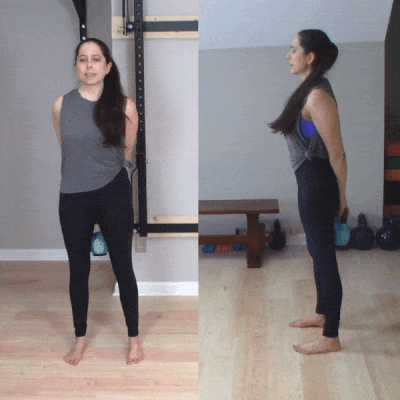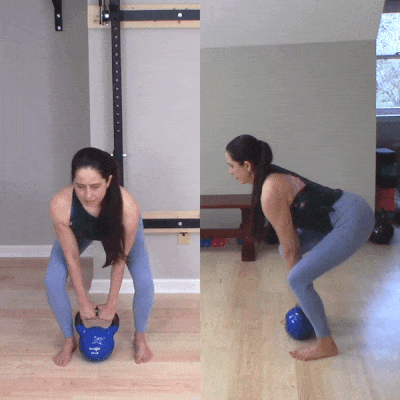The Yogi's Guide to Deadlifting
This blog post was first sent to Jenni’s email list as an email newsletter. Sign up for the JRY email newsletter here!
by Jenni Rawlings & Travis Pollen, PhD
Deadlifts are a foundational exercise that we include in Strength for Yoga Remote Group Training!
Remote Group Training is an all-levels, online strength program specifically designed for yogis to enhance and fill in the gaps in a mat-based practice.
Join us any time – start your free 7-day trial today!
If you’re not familiar with strength training exercises, a “deadlift” might seem like quite a foreign concept. What does deadlift even mean? Are we lifting something that’s not alive? And where are we lifting it to?
It turns out that as strange as the name may seem, a deadlift is actually a quintessential strength training exercise that nearly all weightlifters do on a regular basis. At its essence, a deadlift consists of picking up a low-lying “dead” (stationary) object from the floor.
Just as nearly all yoga practitioners know the familiar flow of sun salutation A, deadlifts are an almost second-nature exercise to nearly all weightlifters. And for good reason! Deadlifts are a perfect and effective choice for:
Building posterior chain strength (think stronger hamstrings, glutes, and spinal extensors)
Developing upper body pulling strength
Improving grip strength
Generally preparing the body to pick heavy items up off the floor
It’s noteworthy that this list of benefits consists of qualities that are all conspicuously absent from a traditional yoga practice. In general, yoga’s potential to strengthen the posterior chain is rather limited, upper body pulling work is almost nonexistent, and grip strength drills are simply not a part of the traditional yoga asana lexicon. And unless a yoga class features some very creative partner work variation in which one yoga student attempts to lift another student off their yoga mat, we simply don’t have the opportunity to practice lifting objects up off the floor in yoga.
For yoga practitioners who might be looking to fill in some of the strength gaps that their practice doesn’t cover, then, a deadlift is an ideal place to start!
Another consideration for yogis regarding deadlifting is that because deadlifts strengthen the hamstrings, they can be a potentially helpful exercise for combatting a condition called proximal hamstring tendinopathy, or high hamstring pain. In the yoga world, this condition is so common that it’s sometimes casually referred to as “yoga butt.” Having strong hamstrings may protect against developing yoga butt, and deadlifts can be an effective means to this goal.
Get Started With Your Deadlift
When it comes to learning how to deadlift, yogis have a bit of a “leg up” compared to most folks. You see, executing a skillful deadlift requires that we understand how to hip hinge. The hip hinge is strength training jargon for a forward bend with a flat back.
Luckily for yogis, hip hinging tends to come relatively naturally because the hip hinge movement pattern is already a built-in ingredient in countless yoga asanas and transitions. Every time we swan dive forward into uttanasana from tadasana, we are hip hinging. Downward facing dog is a hip hinge. And yoga’s hip-hingey halfway lift, or ardha uttanasana, very closely resembles a classic variation of a deadlift called a Romanian deadlift.
Hip Hinge Drills
Although yogis tend to master the hip hinge more quickly than most new strength trainees, the ability to hinge at the hips without rounding the spine can occasionally prove elusive. For this reason, the strength training world has come up with lots of clever ways to “drill” the position. Below, we show the three drills we find ourselves using most often.
Dowel Rod Hip Hinge
Stand tall with your feet between hip and shoulder width apart and toes forward. Hold a dowel rod (or bamboo stick!) on your back so you have three points of contact: head, upper back, and tailbone.
With soft knees (i.e. a small degree of bend), push your hips back as if you were shutting a car door with your rear end. (You can also imagine getting “karate chopped” at your hips.) Ensure that you’re maintaining all three points of contact between the stick and your body. If the stick comes off your tailbone, if means you rounded your back.
Bulgarian Goat Bag Swing
Grip a kettlebell by the horns, and press it into your belly. Hinge at your hips, keeping the kettlebell pressed into your belly.
This drill often works magic for people. To counteract the pull of the kettlebell, you should find yourself reflexively incorporating three essential ingredients of a yummy hinge:
Lifting your chest up: if someone were standing in front of you, they’d be able to see a logo on the front of your shirt
Pulling your shoulders down and back: visualize pulling your shoulders toward your back pockets
Engaging your lats (back muscles): imagine squeezing oranges in your armpits
Kettlebell Handcuff
Hold a kettlebell behind your back as if you were handcuffed, and hinge at your hips.
Whereas in the Bulgarian goat bag swing you have to work yourself into a good position, the handcuff drill almost automatically puts you into that good position.
Note: In an attempt to keep things brief (ha!), we limited this section to three drills, but there are actually quite a few more (e.g. the blocked knee drill, the wall tap drill). It’s not necessary to perform all of the drills under the sun; in fact, oftentimes just one will suffice. But it does sometimes take some trial and error to find the drill that resonates best.
Kettlebell Deadlift Variations
Once you’ve mastered the hip hinge, you’re ready to pick up some weight! The type of weight you use will largely depend on what you have available – be it a kettlebell, dumbbell, barbell, sandbag, or small child. 😉 In our experience, the most beginner-friendly option tends to be the kettlebell. Therefore, we’ll use the kettlebell to illustrate four quintessential deadlift variations: conventional, elevated, Romanian, and sumo.
Kettlebell Romanian Deadlift
The Romanian deadlift (also known as a “stiff-legged deadlift”) is a pure hip hinge with the addition of load.
The key to a crisp deadlift is the setup position. To set up for the Romanian deadlift, straddle the kettlebell with your feet on either side of it. Hip hinge all the way down to grip the kettlebell. (You should feel a good stretch in your hamstrings in this position!) Apply the three cues for a yummy hinge from the Bulgarian goat bag swing.
From there, simply stand up by
Feeling your whole foot on the ground (perhaps with a slight bias towards the heels). Deadlifting barefoot or with minimalist shoes can help facilitate that.
Thrusting your hips forward to meet your hands at the top of the deadlift, engaging your glutes.
Reaching your head for the ceiling to stand tall. (Avoid the urge to lean back at the top.)
Bracing your core like your tummy is about to get tickled or a dog or cat is about to jump on you.
Kettlebell Conventional Deadlift
Most of the time when people talk about a ‘deadlift’ without any accompanying adjectives, they’re referring to the conventional deadlift.
The conventional deadlift is the beautiful stepchild of a hip hinge and a squat. To prepare for the first rep, hip hinge to the point where you start to feel tension in your hamstrings. Then bend your knees the rest of the way down to grip the kettlebell. To stand up, think of “pushing the floor away.” To return the kettlebell to the floor, reverse that motion.
The addition of the knee bend to the hip hinge in the conventional deadlift gets the strong quadriceps involved in the movement in addition to the hamstrings and glutes. For most people, this help from the quads makes the conventional deadlift the strongest position to lift from.
Kettlebell Elevated Deadlift
Not everyone is an ideal candidate for picking up a kettlebell all the way from the floor, at least not right at the beginning of their strength training journey.
If you find yourself struggling to maintain a flat back in the bottom position of a deadlift from the floor, simply raise the kettlebell up on yoga blocks (or any sturdy object) to reduce the range of motion.
Kettlebell Sumo Deadlift
The sumo deadlift is the conventional deadlift’s sister from another mister.
The big difference between sumo and conventional is foot position. In sumo, the feet are wider than shoulder width and the toes are slightly flared out. The torso will also be slightly more upright/vertical in sumo than conventional. Notwithstanding these positional differences, all the same cues apply.
Deadlift Variations with Other Implements
Dumbbell Conventional Deadlift
All of the deadlift variations demonstrated above can just as easily be performed with a dumbbell. For example, here’s a dumbbell conventional deadlift.
As you can see, the only difference between using a dumbbell and kettlebell is how your hands are oriented. With the kettlebell, you use an overhand grip; with the dumbbell, the palms face one another.
Barbell Conventional Deadlift
Some would say that the barbell conventional deadlift is the ultimate expression of strength. As a matter of fact, of all the strength training exercises in existence, the one humans can perform with the most weight is the deadlift. Some strongman competitors can deadlift over 1000 pounds!!
To deadlift the barbell, set up with the bar even with the middle of your foot. Do your hinge then knee bend so your shins are just touching the bar. Grip the bar with your hands just outside your shins.
The trick with the barbell is that because the weight is now in front of you instead of between your legs, you have to navigate the bar around your knees. To stand up, first send your knees back (so you don’t have to pull the bar around them). Once the bar is past your knees, send your hips forward to meet it, like always. To reverse directions, slide the bar down your thighs, keeping your knees back until the bar passes them. Then bend your knees to return the bar to the floor.
There are lots of other great deadlift variations (e.g. suitcase, staggered stance, hockey, Jefferson), but we’ll have to save them for a future Part II. In the meantime, we hope the six variations we’ve described keep you busy gaining strength!
INCORPORATING THE DEADLIFT
Want to learn even more about conventional, sumo, and Romanian deadlifts – including how to progressively load them and how to fit them into a larger strength program?
Look no further! Deadlifts are a foundational exercise in our Strength for Yoga: Remote Group Training program. We teach you everything you need to know about these exercises and so much more!
So what is “Remote Group Training”?
Yoga-specific strength training programs designed by a long-time yoga teacher (Jenni) and an exercise science professor (Travis)
Monthly full-body workouts with a special yoga or strength training theme to enhance and fill in the gaps in a traditional mat practice
Your choice of a 2 or 3 day/week training schedule
Train at home or in the gym
Comprehensive exercise database with over 300 videos!
Community connection, Q&A, and form feedback via an exclusive member forum















